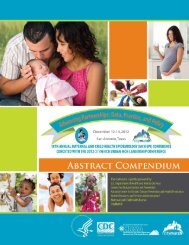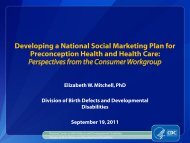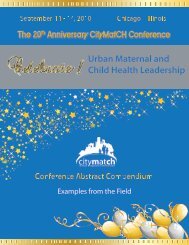2009 <strong>CityMatCH</strong> Urban MCH Leadership <strong>Conference</strong>Women were asked about barriers to PNC. The most common were transportation (25.4%) and clinichours (22.3%). Women with chronic conditions had a mean of 1.87 barriers, whereas women withoutchronic conditions averaged 1.57 barriers. Women with chronic illness were 1.2 times more likely to havea barrier than women without chronic illness (95% CI, 0.6-2.6). Women diagnosed with chronicconditions before pregnancy were 1.5 times more likely to begin PNC after <strong>the</strong> first trimester [definedhere as after 12 weeks (95% CI, 0.3-1.4)] and 2.1 times more likely to delay PNC until after half waythrough pregnancy (95% CI, 0.2-1.4).LIMITATIONSData on presence or absence of chronic conditions were based on self-report. Women may have had prepregnancychronic conditions but did not report <strong>the</strong>m or may have had undiagnosed conditions.Participants are not a random sample of all low-income pregnant women in <strong>the</strong> target communities.Finally, due to small sample size, estimates were unstable.CONCLUSIONS/LIMITATIONSLow-income women with chronic illness appear more likely to have barriers and delay PNC entry. Inorder to actualize PNC benefits, efforts to connect women to care as early in pregnancy as possible areessential. Health outreach prior to pregnancy might be <strong>the</strong> most important strategy.90
2009 <strong>CityMatCH</strong> Urban MCH Leadership <strong>Conference</strong>Innovative strategy to reaching women at-risk for poor pregnancy outcomesPRIMARY CONTACT:Carrie Y Hepburn, MSProject DirectorSt. Petersburg Healthy Start FederalProject/Pinellas County HealthDepartment205 Dr. MLK Street, NSt. Petersburg, FL, 33701Phone: (727) 820-4152Fax: (727) 820-4278Email: caroline_hepburn@doh.state.fl.usCATEGORYInfant mortality and morbidityRacial and ethnic health disparitiesFOCUSProgram Policy FocusCO-PRESENTER(S)/AUTHOR(S):Carrie Hepburn,caroline_hepburn@doh.state.fl.us (Presenter)Angela Horvath, angela_horvath@doh.state.fl.us(Presenter)ISSUEThe St. Petersburg Healthy Start Federal Project (Project) strives to eliminate disparities in infantmortality and o<strong>the</strong>r perinatal outcomes. Most recent data (2007) reveals that <strong>the</strong> Black infant mortalityrate (15.9) is almost three times <strong>the</strong> White infant mortality rate (5.5). A three-year case study review ofBlack women in Pinellas County experiencing an infant loss revealed that many of <strong>the</strong>m had risk factorssuch as repeated STDs, chronic health problems, previous poor birth outcomes, and emotional healthissues.SETTINGThe Project serves an estimated subpopulation of 12,000 African American women of child-bearing age,2,000 African American infants up to age 2 years, and <strong>the</strong>ir families residing in a four contiguous zip codearea in South St. Petersburg located in Pinellas County, Florida.PROJECTAs a federally-funded Healthy Start Program, <strong>the</strong> St. Petersburg Healthy Start Federal Project provides allrequired core services including: outreach and client recruitment, case management, health education,interconceptional care and depression screening and referral. In response to data collected through annualcase study reviews, a new approach was implemented to reach women at-risk for poor pregnancyoutcomes. The case study reviews elucidated that over 80% of Pinellas County Black women with aninfant loss had received services at <strong>the</strong> Pinellas County Health Department. As a result, <strong>the</strong> Project created<strong>the</strong> position of Clinic Resource Specialist (CRS). The CRS addresses <strong>the</strong> needs of at-risk womenpresenting to <strong>the</strong> health department. The CRS, a social worker, identifies risk factors assesses clientneeds, delivers education and provides community referrals.91







